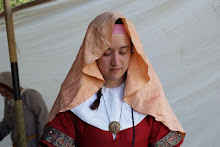Wool trade, multiple spinning bobbins, Isaac Claes Swanenburgh, 1614-1638, London History Museum, tec01011, copyright Kathleen Cohen. source: http://www.engr.sjsu.edu/pabacker/history/middle.htm#Weaving%20and%20the%20Textile%20Industry
Today, being Ada Lovelace day, I'd like to post some items regarding women in medieval technology. First, a few links.
This fantastic article covers women's roles in various guilds, including several women in charge of quite large foundries. http://www.virtualworldlets.net/Papers/Hosted/WomenMed.php
I did a fair amount of searching and found no information whatsoever on them, excepting a few church records marking their donations. Joan Hille also appears in the records of Little Staughton as the maker of one of their 5 churchbells (From: 'Parishes: Little Staughton', A History of the County of Bedford: Volume 3 (1912), pp. 165-168. URL: http://www.british-history.ac.uk/report.aspx?compid=42407 )
Next up is the illustrious Byzantine Empresses Zoe and Theodora. The sisters ruled together in the early 11th century, and quite the controversial pair. Zoe herself managed to marry three times (two of the three met with unfortunate ends: her first husband Romanus was found dead in his bath, and the empresses blinded and exiled her second husband Michael V), and took her first husband at the age of 50! What makes them relevant to this post is that both of them were avid perfumers.
Michael Psellus wrote about them in his Chrongraphia: "[Zoe's] own private bedroom was no more impressive than the workshops in the market where the artisans and the blacksmiths toil, for all round the room were burning braziers, a host of them. Each of her servants had a particular task to perform: one was allotted the duty of bottling the perfumes, another of mixing them, while a third had some other task of the same kind. In winter, of course, these operations were demonstrably of some benefit, as the great heat from the fires served to warm the cold air, but in the summer-time the others found the temperature near the braziers almost unbearable. Zoe herself, however, surrounded by a whole bodyguard of these fires, was apparently unaffected by the scorching heat. In fact, both she and her sister seemed naturally perverse. They despised fresh air, fine houses, meadows, gardens; the charm of all such things meant nothing to them."
Psellus's text can be read on the Medieval Sourcebook, here: http://www.fordham.edu/halsall/basis/psellus-chronographia.html
Moving right along, we have the fabulous Martine de Bertereau (born in 1601), the first woman minerologist. This is decidedly past the middle ages, but she is too interesting to leave out! After marrying her husband (a mine inspector in Germany), they travelled as far as South America inspecting the mines there, as well as in Hungary, Germany, and France. In 1640, she wrote "La Restitution de Pluton", with the purpose of persuading Cardinal Richelieu to open and utilize the mines located in France. He responded by throwing their entire family in prison on suspicion of witchcraft (the use of divining rods was part of their work), where she soon died.
Some facsimile pages of her work can be found here: http://envor2004.free.fr/cariboost1/crbst_3.html
Then, earlier, in the 11th century we have Trotula, the first recorded female physician, who was known for her crazy ideas, such as the administration of painkillers to women during childbirth, and that both women and men could be responsible for infertility. Additionally, she was a leader in the fields of gynecology and nutrition. Her works include "Passionibus Mulierum Curandorum" (The Diseases of Women) and "Practica Secundum Trotam". A much better article on her than I could ever write can be found here: http://www.doctorsreview.com/node/57
Trotula wasn't alone, however, and we have quite a few noted Italian female physicians in the middle ages. In Italy, women were allowed to study at university up to 1500, so it was no surprise that it is only here that we really see women taking their place as doctors. In addition to Trotula, Italy can boast of (to name a few): Dorotea Bucca, the chair of medicine and philosophy at the University of Bologna from 1390 (holding the post for 40 years); Abella, a 14th century physician in Salerno, who authored "De atrabile" (Black Bile) and "De natura seminis humani" (Nature of seminal fluid); Jacobina Félicie, a 13th century Florentine, fought the law when she moved to Paris, where only members of the (all male) medical faculty were allowed to practice; Alssandra Giliani was a leading anatomist and surgical assistant in 14th century Bologna, and is known for discovering a way to replace blood with a dye to assist the study of veins; Mercuriade, who's work in 14th century Salerno included various works on fevers and ointments; Constance Calenda who worked in 15th century Salerno; Calrice di Durisio was a 15th century eye specialist; Maria Incarnata was a Napolitan surgeon.
Here are sources for more on these Italian doctors:
And finally, athough a bit past the middle ages, is Maria Cunitz (born in 1604), noted astronomer and author of "Urania propitia" (1650). .
Follow this link for an incredible article about her life and achievements: http://web.clas.ufl.edu/users/rhatch/pages/03-Sci-Rev/SCI-REV-Home/sr-women/05-SR-WOMEN-CUNITZ-PAGE-bio.html
